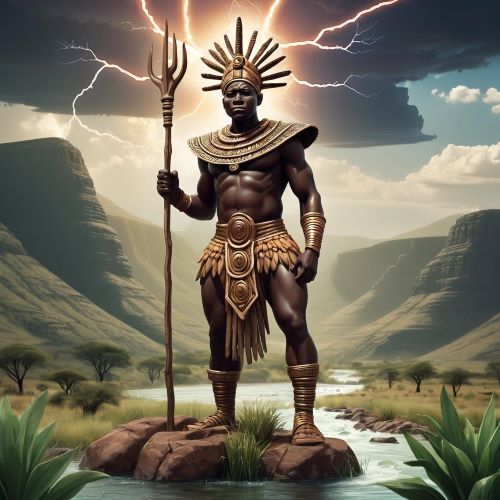Sotho & Tswana Mythology
Sotho and Tswana mythology, rooted in the high plateaus and valleys of southern Africa, embodies the spiritual essence of the Basotho and Batswana peoples — communities bound by shared Bantu origins, rich oral traditions, and a deep reverence for ancestors. Their belief systems, shaped by centuries of life close to the land, emphasize balance between the living, the dead, and the divine. The myths of these two closely related cultures reveal a universe animated by moral order, ancestral guidance, and the ever-present breath of the Creator.
At the center of Sotho and Tswana cosmology stands Modimo, the supreme being and creator of all life. His name, meaning “The Great One” or “He Who Is Above,” reflects his role as both transcendent and ever-present. Modimo is not worshipped through images or temples but through reverence, song, and moral living. He is believed to have created the heavens, the earth, and all living things, endowing humanity with seriti — the divine life force or spiritual dignity that connects every being to the cosmos. The Basotho and Batswana view life as a sacred gift, sustained by Modimo’s breath and guided by the wisdom of the ancestors, known as Badimo.
The Badimo are central to both Sotho and Tswana spirituality. They are not distant spirits but living presences within the community — ancestors who watch over their descendants, ensuring fertility, health, and moral order. Offerings of beer, grain, and water are made at family altars or sacred trees to honor them. The relationship between the living and the Badimo is reciprocal: respect ensures protection and prosperity, while neglect invites misfortune. To live in harmony with the Badimo is to live in alignment with the will of Modimo.
In Sotho mythology, the origins of humanity and moral law are often explained through allegory. One popular myth tells how the first humans emerged from a hole in the earth called Lehono la Modimo, the “Place of Creation.” The ancestors were sent forth to populate the world, but one group disobeyed divine instruction and caused chaos, leading to the division of light and darkness. This myth, like many others, teaches humility and the importance of order, unity, and respect for divine law.
Tswana mythology shares similar creation themes but emphasizes cosmic balance and social responsibility. The Tswana tell stories of Matsieng, the first ancestor who led humanity and animals out of a sacred cave called Lowe, bringing with him cattle, fire, and the arts of civilization. Matsieng’s footprints are said to still exist in stone — physical reminders of humanity’s divine origin. His tale affirms the Tswana belief that leadership and creativity are sacred trusts, inherited from the gods and maintained through moral conduct.
Together, Sotho and Tswana mythology form a spiritual philosophy grounded in respect, harmony, and continuity. They teach that the divine is not confined to heaven — it lives in the wind that moves across the plains, the rhythm of cattle bells, and the voices of the ancestors who never truly leave.


